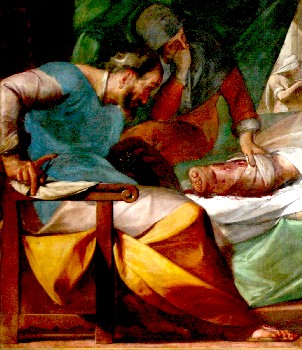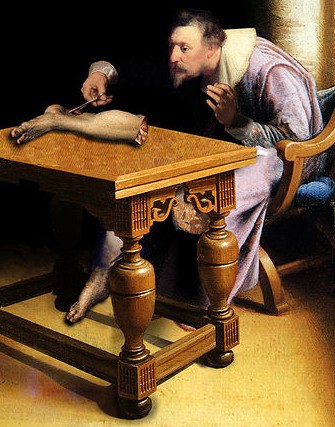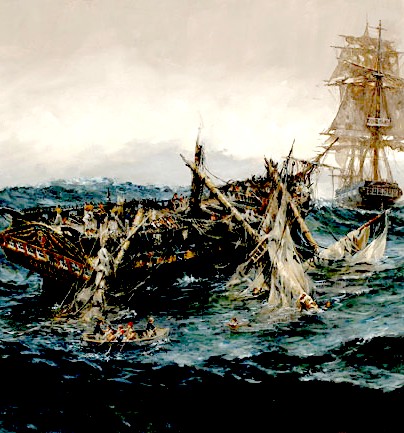
Amputation Page Menu: 1 2 3 4 5 6 7 8 9 10 11 12 Next>>
Amputation During the Golden Age of Piracy, Page 2
Reasons to Amputate
Surgical authors during the Golden Age of Piracy identify several reasons for performing an amputation. Some are obvious, others a bit more obscure. Below are four of the most interesting.
The First Reason to Amputate: Gangrene
"When an Arm or Leg is mortified, and the natural heat is absolutely extinct, we cannot dispense with cutting it off, since there is no other way left of recalling the Life of the rest, and if it be deferr'd, the Evil will increase." -Pierre Dionis, p. 403

"Miracolo di Aurelia Degl Angeli"
by Giovanni Battista Crespi (1610)
Gangrene was a much feared consequence of wounds, as well it should have been. At this time, there was no known way
to prevent a gangrene once it had proceeded to what was referred to as 'sphacelus.'
A sphacelated limb was one that had lost all blood flow to it, causing it to turn black and die. Period
surgeons knew that if the sphacelated limb wasn't removed from the body,
the patient would also eventually die.
With this in mind, John Woodall advised, "...if the occasion of dismembering proceede of a Gangrene, by reason of an inward cause, it were requisite to take the member off foure fingers above the Gangrene at the least, if the member will beare it..."1 Woodall suggested cutting into the healthy flesh for fear that the gangrene would spread.
The existence of gangrene didn't always mean that a limb had to be amputated. Surgeons during the Golden Age of Piracy had methods for dealing with gangrenes which hadn't reached sphacelation. (To learn more about these treatments, check out the page on gangrene treatments.) However, once the limb began to blacken, it was generally agreed that "you are to proceed with the Extirpation of that rotten Member while the Patient is free from Delirium, and hath strength to bear the Operation."2
If the surgeon waited too long, the disease progressed. Matthias Purmann warned, "...when [the surgeon] sees no Medicines will take place, to undertake the Amputation time enough; the sooner the better, for if you stay till the Gangrene is come over the Knee, and above the Elbow near the Shoulder, its then gone too far, and Amputation will do no good."3
1 John Woodall, the surgions mate, p. 176; 2 Richard Wiseman, Of Wounds, Severall Chirurgicall Treatises, p. 452; 3 Matthias Gottfried Purmann, Churgia Curiosa, p. 209
A Second Reason to Amputate: 'Plaining' the Stump
"…usually when the Member is shattered, it hangs by some little part of a Tendon, Musculous flesh, or Skin. In which case your work is, with a good Razour or Knife presently to plain the Stump, and pull up the Flesh, that you may saw off the end of the Bone close to it." -Richard Wiseman, p. 421
It seems to have been a common enough for a limb being totally or nearly totally removed in battle for several period surgical authors discuss how to finish the job that warfare had begun. This was not an uncommon problem. Slave ship captain Thomas Phillips mentioned that following a battle with a French Frigate, "the carpenter had his arm shot off, and three others their legs"1. Such wounds would almost certainly require 'planing'.
John Moyle gives us a full account of such treatment on a sailor's shoulder:

Philippe Verheyen Dissecting His Amputated Limb (1715-1730)
"In time of Fight at Sea a Man had his Arm carried off by a Bullet from the Enemy. The Bone was
shatter'd all to pieces and was so near the Shoulder Joint, that there was not room for Amputation
with the Saw to make a smooth end of the stump."
"There were some quassate loose Ossicles [small loose bones or possibly pieces of the bone] at the end of the Bone, which I took out immediately with Forceps; others there were, but not so loose as to be now extracted. Some of the ends of the Nerves were hanging out, as also some lacerated Flesh and Skin, which were now cut off, as even as possible."2
French surgeon Pierre Dionis gives us a detailed and clinical account of how to complete the procedure of amputation for members that have been violently removed. (I have inserted a paragraph break into his explanation for ease of reading.)
A Cannon Bullet carries off a Leg or an Arm; in which case no Deliberation is to be made on the Operation, since 'tis already done; but the Chirurgeon has yet two things to do; the first is, to saw off the end of the Bone, which is never broken so exactly, as not to leave some Fragments or Points to be cut off, that it may not come out beyond the Flesh; the second, is, to prevent or stop the Hæmmorhage, by binding the Vessels, or applying Vitriol Buttons [pieces of caustic material which burn the bleeding vessels closed], or other Styptics, of which I shall speak hereafter.
For though the Blood is generally stopped by the Fire of the Bullet, the Scar coming to fall off some Days after, the Blood will issue out in abundance, and the wounded Patient may die, if the Chirurgeon is not upon his Guard. When the Part is not wholly disengaged, and it hangs by some Fragments of Flesh, he is, with his Incisions Knife or Scissars, to cut off and dress the Patient, as if he fear'd a Hæmmorhage.3
1 Thomas Phillips, 'A Journal of a Voyage Made in the Hannibal', A Collection of Voyages and Travels, Vol. VI, Awnsham Churchill. ed., p. 181; 2 John Moyle, Memoirs: Of many Extraordinary Cures, p. 52-3; 3 Pierre Dionis, A course of chirurgical operations: demonstrated in the royal garden at Paris. 2nd ed., p. 406
Two Other Reasons to Amputate
Pierre Dionis provides two other reasons for amputation, one of which has direct bearing on the sea surgeon, the other being more of a curiosity.

The losing end of a tall ship battle, no doubt resulting in many amputations
'Musquet' balls
Bullets could result in the splintering of bones. Dionis explains, that when a limb is damaged from a musket-ball wound, "all the Bones of the Arm or Leg are broken, and there are several Splinters, as though we had broken a Wall-nut, we can scarce avoid Amputation; or if the Ball is enter'd in a Hand or Foot, and has made great Ravage, 'tis also difficult to preserve these Parts."1
Caries of the Bone
Dionis also advises amputation when the bone of a limb has become corrupted and progressively decays, something which was felt to be caused by 'caries' during this period. When this occured, Dionis warned that "in despite of Remedies evacuates them as though they were eaten by Worms."2 He then goes on to provide a case study.
Ten Years since we were forced to cut off the Leg of one of the young Men of the Castle of Versailes, by reason of an old Caries which could never be stopped, and which and which consumed his Bones, as tho' they had been all Worm-eaten: Of this he was well cured, and is at present in good Health.3
Dionis lists a variety of other possible causes of caries:
When an acrimonious and corrosive Serosity, like Aqua fortis [Nitric acid in water] gets betwixt the Bones of the Corpus or Tarsus [skeleton], it does not quit them 'till it has made them fall to pieces. A scrophulius or virulent Humour also mixes it self with the other, and they working jointly on the Bones, put them in such Disorder that after having dress'd them several whole Years, we find our selves at last forced to come to the last Remedy, which is Extirpation [amputation].4
1,2,3,4 Pierre Dionis, A course of chirurgical operations: demonstrated in the royal garden at Paris. 2nd ed., p. 406

